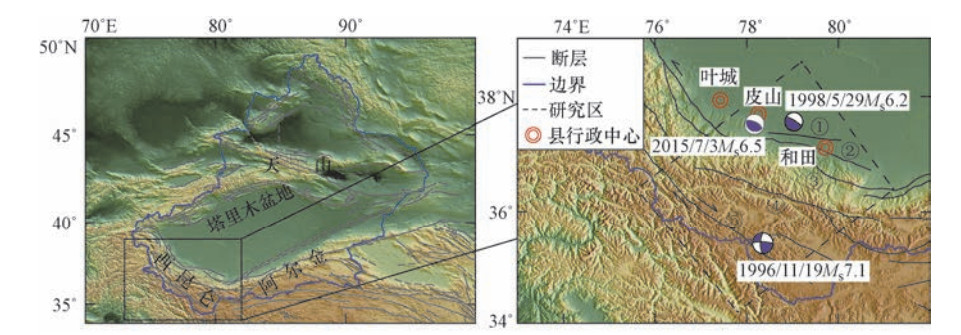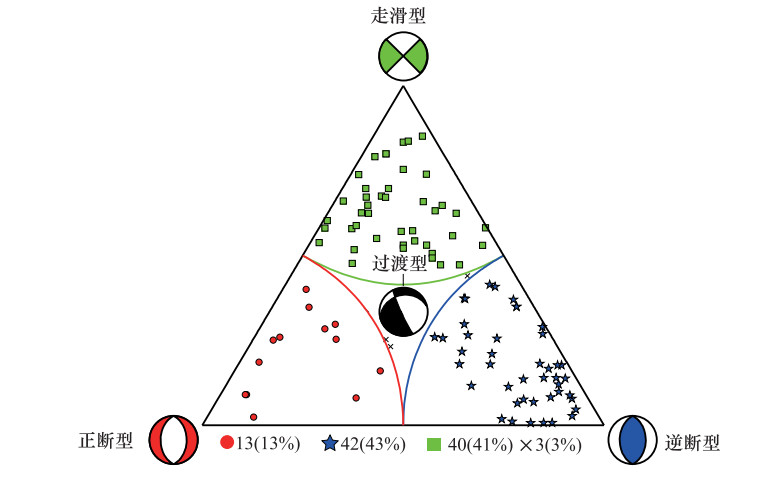The Focal Mechanism and Stress Field Inversion in the Eastern Section of West Kunlun
-
摘要: 本文利用新疆测震台网记录的宽频带波形数据,采用CAP方法反演西昆仑东段2010年1月—2018年12月MS≥3.0地震震源机制,并结合研究区早期的震源机制数据分区反演构造应力场。结果表明:研究区地震破裂类型以逆断型和走滑型为主,其次为正断型,过渡型最少;震源机制节面在NWW向存在明显优势分布且倾角较陡,压应力P轴在NNE向有优势分布且倾角较小,张应力T轴在NW-SE向有优势分布且倾角较小,说明研究区总体上主要以NNE向的水平挤压和NW-SE向水平拉张作用为主;西南区域应力结构为走滑型,东北区域应力结构为逆断型,最大主应力轴σ1方位的最优解都呈NNE向,但西南区域更偏东,东北区域水平作用更明显。东北区域的应力形因子R值较小,体现该区域的物质隆升相对于西南区域物质隆升分量大。Abstract: In this paper, based on the broadband waveform data recorded by Xinjiang Seismic Network, the focal mechanism of MS≥3.0 earthquake from January 2010 to December 2018 are inverted by CAP method in the eastern section of West Kunlun. Combined with the focal mechanism data in the early stage, the stress field in the study area is inversed. The results show that the seismic rupture types are mainly thrust type and strike-slip type, followed by normal fault type, and the transition type is the least in the study area. Nodal plane of focal mechanism is near NWW, the inclination angle is steep. P axis is near NNE, and the inclination angle is small.T axis is near NW-SE, the inclination angle is small. It indicates that the stress field of study area is mainly under action of NNE horizontal compression and the NW-SE horizontal tensional; The inversion results show that the stress structure in the southwest and northeast regions is quite different, the stress structure in the southwest region is strike-slip type, the stress structure in the northeast region is thrust type. The optimum solution of the maximum principal stress σ1 are NNE direction in southwest region and northeast region, but the southwest region is more east, and the horizontal effect in the northeast region is more obvious. The stress shape ratio R indicates that the material uplift in the southwest region is smaller than that in the northeast region.
-
Key words:
- West Kunlun /
- Focal mechanism /
- Stress field /
- CAP /
- MSATSI
-
表 1 构造应力场分区反演结果
Table 1. Result of stress field inversion
分区 ${\sigma _1}$ ${\sigma _2}$ ${\sigma _3}$ 应力形因子R 方位/° 倾角/° 方位/° 倾角/° 方位/° 倾角/° 东北 14
(-76—94)14
(-7—36)106
(16—194)10
(-38—77)-129
(-308—-48)73
(3—89)0.41
(0.06—0.98)西南 29
(-1—93)26
(-8—64)169
(79—299)57
(-18—83)-70
(-214—-8)18
(-71—75)0.62
(0.13—0.99)注:以上的数值范围为各参数在95%置信度下的不确定性范围。 -
高国英, 聂晓红, 龙海英, 2010. 2003-2008年新疆区域构造应力场特征探讨. 地震地质, 32(1): 70—79. doi: 10.3969/j.issn.0253-4967.2010.01.007 高锐, 黄东定, 卢德源等, 2000. 横过西昆仑造山带与塔里木盆地结合带的深地震反射剖面. 科学通报, 45(17): 1874—1879. doi: 10.3321/j.issn:0023-074X.2000.17.015 郝平, 吕晓健, 田勤俭等, 2012. 中国西部及邻区活动地块边界带现代构造应力场. 地震学报, 34(4): 439—450. doi: 10.3969/j.issn.0253-3782.2012.04.002 环文林, 汪素云, 时振梁等, 1980. 青藏高原震源分布与板块运动. 地球物理学报, 23(3): 269—280. doi: 10.3321/j.issn:0001-5733.1980.03.004 黄骥超, 万永革, 盛书中等, 2016. 汤加-克马德克俯冲带现今非均匀应力场特征及其动力学意义. 地球物理学报, 59(2): 578—592. https://www.cnki.com.cn/Article/CJFDTOTAL-DQWX201602017.htm 雷东宁, 蔡永建, 李媛, 2018. 西藏喀喇昆仑断裂东南段晚第四纪活动的地质地貌特征. 科学技术与工程, 18(32): 152—156. doi: 10.3969/j.issn.1671-1815.2018.32.022 李茂玮, 1994. 帕米尔—西昆仑地震带强震活动的规律性特征. 内陆地震, 8(2): 134—140. https://www.cnki.com.cn/Article/CJFDTOTAL-LLDZ402.004.htm 李艳永, 王成虎, 杨佳佳, 2018. 呼图壁地区震源机制解及构造应力场特征分析. 大地测量与地球动力学, 38(12): 1246—1250. https://www.cnki.com.cn/Article/CJFDTOTAL-DKXB201812007.htm 李莹甄, 张博, 殷娜等, 2016. 新疆及周缘构造破裂特征及地震序列类型. 地震工程学报, 38(1): 36—45. doi: 10.3969/j.issn.1000-0844.2016.01.0036 刘栋梁, 李海兵, 潘家伟等, 2011. 帕米尔东北缘-西昆仑的构造地貌及其构造意义. 岩石学报, 27(11): 3499—3512. https://www.cnki.com.cn/Article/CJFDTOTAL-YSXB201111029.htm 刘兆才, 万永革, 黄骥超等. 2019. 2017年精河MS6.6地震邻区构造应力场特征与发震断层性质的厘定. 地球物理学报, 62(4): 1336—1348. https://www.cnki.com.cn/Article/CJFDTOTAL-DQWX201904013.htm 王琼, 聂晓红, 高朝军, 2012. 1950年以来帕米尔东北缘一西昆仑地区7级左右地震后新疆地区中强地震活动状态分析. 地震, 32(1): 93—102. https://www.cnki.com.cn/Article/CJFDTOTAL-DIZN201201009.htm 王晓楠, 唐方头, 邵翠茹, 2018. 南迦巴瓦构造结周边地区主要断裂现今运动特征. 震灾防御技术, 13(2): 267—275. http://zzfy.eq-j.cn/zzfyjs/ch/reader/view_abstract.aspx?flag=1&file_no=20180202&journal_id=zzfyjs 王晓山, 吕坚, 谢祖军等, 2015. 南北地震带震源机制解与构造应力场特征. 地球物理学报, 58(11): 4149—4162. https://www.cnki.com.cn/Article/CJFDTOTAL-DQWX201511023.htm 谢富仁, 崔效锋, 赵建涛等, 2004. 中国大陆及邻区现代构造应力场分区. 地球物理学报, 47(4): 654—662. doi: 10.3321/j.issn:0001-5733.2004.04.016 徐晓尹, 蔡志慧, 何碧竹等, 2016. 塔里木盆地西南缘盆山结合带东段逆冲体系的形成及演化过程. 岩石学报, 32(12): 3743—3752. https://www.cnki.com.cn/Article/CJFDTOTAL-YSXB201612013.htm 许忠淮, 2001. 东亚地区现今构造应力图的编制. 地震学报, 23(5): 492—501. doi: 10.3321/j.issn:0253-3782.2001.05.005 张广伟, 雷建设, 2015. 2015尼泊尔MS8.1地震中等余震震源机制研究. 地球物理学报, 58(11): 4298—4304. https://www.cnki.com.cn/Article/CJFDTOTAL-DQWX201511035.htm 张志斌, 冉慧敏, 金花, 2019a. 2016年12月8日新疆呼图壁MS6.2地震发震构造初步研究. 地震工程学报, 41(4): 962—969. 张志斌, 金花, 朱皓清, 2019b. 2018年9月4日伽师MS5.5地震与97年及03年伽师强震属于同一发震构造吗? 地球物理学进展, 34(6): 2232—2238. https://www.cnki.com.cn/Article/CJFDTOTAL-DQWJ201906013.htm 赵佳楠, 田淑芳, 2013. 新疆塔什库尔干地区柯岗断裂性质及遥感地质解译. 新疆地质, 31(2): 152—155. doi: 10.3969/j.issn.1000-8845.2013.02.009 Frohlich C., 1992. Triangle diagrams: ternary graphs to display similarity and diversity of earthquake focal mechanisms. Physics of the Earth and Planetary Interiors, 75(1—3): 193—198. doi: 10.1016/0031-9201(92)90130-N Fu B. H., Ninomiya Y., Guo J. M., 2010. Slip partitioning in the northeast Pamir–Tian Shan convergence zone. Tectonophysics, 483(3—4): 344—365. doi: 10.1016/j.tecto.2009.11.003 Hardebeck J. L., Michael A. J., 2006. Damped regional-scale stress inversions: methodology and examples for southern California and the Coalinga aftershock sequence. Journal of Geophysical Research: Solid Earth, 111(B11): B11310. http://gji.oxfordjournals.org/external-ref?access_num=10.1029/2005JB004144&link_type=DOI Martínez-Garzón P., Kwiatek G., Ickrath M., et al, 2014. MSATSI: a MATLAB package for stress inversion combining solid classic methodology, a new simplified user-handling, and a visualization tool. Seismological Research Letters, 85(4): 896—904. doi: 10.1785/0220130189 Zhao L. S., Helmberger D. V., 1994. Source estimation from broadband regional seismograms. Bulletin of the Seismological Society of America, 84(1): 91—104. http://gji.oxfordjournals.org/cgi/ijlink?linkType=ABST&journalCode=ssabull&resid=84/1/91 Zhu L. P., Helmberger D. V., 1996. Advancement in source estimation techniques using broadband regional seismograms. Bulletin of the Seismological Society of America, 86(5): 1634—l641. http://gji.oxfordjournals.org/cgi/ijlink?linkType=ABST&journalCode=ssabull&resid=86/5/1634 -




 下载:
下载:





